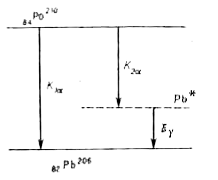In the investigation of the alpha-decay of polonium, alpha-particles with energies of 5.30 and 4.50 MeV were detected. Find the energy of the gamma-rays emitted in the decay, taking account of the recoil of the nucleus.
The correct Answer is:0.82MeV
We might at first reason that the energy of gamma-photons is
εγ=5.30−4.50=0.80MeV. However, this estimate is too rough, since it takes no account of the recoil energy of the nucleus. Certain problems in nuclear physics demand a much higher accuracy. Consider the energy level diagram for the case of polonium decay. The letter Pb∗ with an asterisk denotes the excited lead nucleus which emits gamma-photons. The total energy of the transition is ε1=K1α+R1,where K1α=5.30MeVandR1 is the recoil energy of the nucleus. Since R1−4K1α/206, it follows that
ε1=5.30+(5.30×4/206)=5.40MeV
Similarly, the energy liberated in the course of the second transition is
ε2=4.50+(4.50×4/206)=4.58MeV
The energy of the gamma-photon is
εγ=ε1−ε2=5.40−4.58=0.82MeV
Note that because the mass of the lead nucleus is large, we can neglect the recoil energy resulting from the emission of a gamma-photon.

Similar Questions
The alpha-decay of Po210 nuclei (in the ground state) is accompanied by emission of two groups of two groups of alpha-particles with kinetic energies 5.30 and 4.50MeV. Following the emission of these particles the daughter nuclei are found in the ground and excited states. Find the energy of gamms-quanta emitted by the excited nuclei.
View SolutionA polonium nucleus transforms into one of lead. Find the kinetic energy of the alpha-particle and of the recoil nucleus.
View SolutionThe α− decay of .210Po nuclei (in the ground state) is accompanied by emission of two groups of α−particles with kinetic energies 5.30 & 4.50 MeV. Following the emission of these particles the daughter nuclei are found in the ground & excited states. find the energy of gamma-quanta emtted by the excited nuclei.
View SolutionThe α-decay of nucleus X230 is accompanied by emission of two groups of α−particles-one group having α−particles of kinetic energy 6.7MeV and other having α-particles of kinetic energy 5.2 MeV. Following the emission of these particles the daugheter muclei are found in ground and exiceted states. find the energy of gamma photon. that is subsequenctly emitted by de-exictation of the excited daughter nuclei. Assume that nuclei of X230 are at rest.
View SolutionA stationary Pb200 nucleus emits an alpha-particle with kinetic energy Tα=5.77MeV. Find the recoil velocityof a daughter nucleus. What friction of the total energy liberated in this decay is accountd for by the recoil energy of the daughter nucleus?
View SolutionA stationary .20082Pb nucleus emits an α-particle with kinetic energy Tα=5.77MeV. Find the recoil velocity of a daughter nucleus. What fraction of the total energy liberated in this decay is accounted for by the recoil energy of daughter nucleus ?
View SolutionA radon nucleus with an atomic mass of 216 emits an alpha- particle with an atomic mass 4 and a kinetic energy 8 MeV. What is the energy of the recoil nucleus?
View SolutionThe stationary Pb200 nucleus emits an α with a K.E. ,K=5.77 Me V.Find the recoil velocity of daughter nucleus.What fraction of the total energy liberated in this decay is accounted for by the recoil energy of the daughter nucleus?
View SolutionThe nucleus 23592Y , initially at rest, decays into 21390X by emitting an α-particle
23592Y→23190X + energy,
The binding energies per nucleon of the parent nucleus, the daughter nucleus and α-particle are 7.8 MeV, 7.835 MeV and 7.07 MeV, respectively. Assuming the daughter nucleus to be formed in the unexcited state and neglecting its share in the energy of the reaction, find the speed of the emitted α-particle, [Mass of particle =6.68×10−27kg]
View SolutionThe alpha particles emitted by radium have energies of 4.777MeV and 4.600MeV.What is the wavelength in pm of the gamma rays accompanying the decay? The difference in energies of alpha particle emitted out is equal to the energy of gamma rays.Report your answer to nearest integer.(h=6.626×10−34 Joule.sec,charg "]
View Solution
